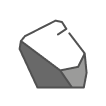HOW DOES IT WORK?
How does it work?
Take a stone
The resulting kidney stone - whether it came out on its own or was assisted by a urologist - is placed in a small container or plastic bag.
Add your contacts
Enter your first name, last name, personal identification number and e-mail address.
Put it all in an envelope
On the envelope, write the address:
„Urolit", SIA
Gardenes iela 13,
Riga, LV-1002
A little patience
Spectrometric analysis of your kidney stone is performed within 5-8 working days.
Get the results
You can see the results of the kidney stone composition at www.datamed.lv
Request a consultation
Make an appointment with a urologist to get a comprehensive answer and plan for further tactics.
SERVICES
PAKALPOJUMI
Analīze - 58.00 EUR
Atsūti akmeni un saņem rezultātu
Konsultācija - 50.00 EUR
Urologa konsultācija
Komplekts - 90.00 EUR
Nierakmens FTIR analīzes un urologa konsultācija
Atkārtota konsultācija - 35.00 EUR
3 mēnešu laikā kopš pirmreizējās vizītes
BENEFITS
Be informed
Get the exact answer to what your kidney stone is made of.
A proven method
Spectrometric analysis of kidney stones is widely used worldwide.
Save time
Save your time and money by simply sending your kidney stone to our clinic. You will receive an answer within 5-8 working days at www.datamed.lv
Consulted by an experienced urologist
After receiving an analysis of the stone's composition, apply for a consultation and receive a comprehensive answer about the next tactics.
Confidential
All data is confidential, you can access it remotely at any time.
MY CV
A little insight into my career
ENDOGLOBE Webinar ECIRS & PCNL - LIVE SURGERY with Prof. Evangelos Liatsikos. The Co-Moderator Dr. Oskars Yakusenoks from Paula Stradins Clinical University Hospital.
Mass PrMasterclass in endoscopic stone removal. Dr. Janak Desai Samved Medicare Hospital. Ahmedabad, India
The intensive course in laparoscopic urological surgery IRCAD Hôpitaux Universitaires 1, Strasbourg (France).
Minimally Invasive Percutaneous Stone Therapy Clinical Workshop. Department of Urology and Andrology, General Hospital Hall in Tirol, Austria, Tirol (Austria)
Workshop – prostate biopsy ultrasound guided and MRI targetes. Cluj Napoca, Romania.
Clinical immersion – advanced urological Lap techniques. Cracow, Poland.
Scientific education four junior uro oncologists on castrate-Resistant Prostate Cancer, Copenhhagen (Denmark)
Latvian University. Residency in urology specialty
Trained in Germany. SRH Zentralklinikum Suhl.
Riga Stradins University. Obtained doctor's degree.
FAQS
Got questions? Read the frequently asked questions, maybe your question has already been answered
So what exactly is a kidney stone?
A kidney stone (also called kidney calcification, nephrolithiasis, or urolithiasis) is a hard deposit formed from minerals and salts that form in the kidney's hollow system. At first, they are small in size (1-3 mm in diameter), but they can also grow in size, even filling the entire renal hollow system. When kidney stones are in the renal hollow system, they will most often not cause any complaints, but at any moment they can start to move along the ureter (the tube that connects the renal hollow system to the bladder) and, when stuck in it, cause renal colic, which results in very severe pain.
What are the symptoms?
What are the symptoms? A kidney stone by itself does not cause any complaints, they appear when it starts to move in the field from the hollow system of the kidney through the ureter and, getting stuck in it, blocks the flow of urine from the kidney to the bladder, which in turn causes urostasis in the kidneys. At this moment, one of the following symptoms may appear: • strong, sharp pain in the side and back, under the rib cage; • pain that may radiate to the lower abdomen and pelvis; • pain that appears in waves with variable intensity; • painful or burning sensation when urinating. Other signs and symptoms may include: • pink, red or brownish urine; • cloudy urine or urine with an unpleasant smell; • a constant need to urinate, urinate more often than usual or urinate in small portions; • nausea and vomiting; • increased body temperature and fever, accompanied by a urinary tract infection.
How is it diagnosed / discovered?
In an acute situation, kidney stones are diagnosed by their characteristic symptoms, blood and urine tests, as well as radiological examinations. Diagnosis is based mainly on radiological examinations. If in the past they were mainly X-ray and ultrasonoscopy examinations, nowadays the computed tomography examination has become the standard examination due to the extensive information it provides.
What to do if a kidney stone is found?
If the situation is acute - the kidney stone is stuck in the ureter and causes renal colic, then you should immediately go to the nearest emergency medical center, where you will be provided with the appropriate help. If the kidney stone is found as an accidental/accidental finding, then you should see an outpatient urologist, who will then also advise you. It is important to receive information about kidney stone size, location, and possible treatment methods and approaches that vary in size and effectiveness
Why is it important to determine exactly what your kidney stone is made of?
According to the guidelines of the European Association of Urologists, it is recommended that all patients who have been diagnosed with kidney stones undergo an analysis of their composition in order to predict and prevent the recurrence of kidney stones. Which in turn can save you from an unwanted return to hospital with renal colic.












